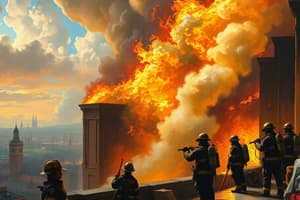Podcast
Questions and Answers
What is the primary responsibility of the Scribe at an EMS scene?
What is the primary responsibility of the Scribe at an EMS scene?
- Gather demographic data and medical history. (correct)
- Perform a patient assessment and develop a care plan.
- Apply ECG and monitor vital signs.
- Responsible for transferring care to the transport provider.
Which crew member is responsible for the complete report of patient status upon transfer of care?
Which crew member is responsible for the complete report of patient status upon transfer of care?
- Company officer.
- Support Care provider.
- Primary Patient Care provider. (correct)
- EMSA paramedic.
What should the company officer consider when retrieving firefighters from the hospital?
What should the company officer consider when retrieving firefighters from the hospital?
- The social needs of the community.
- The ability of the company to return to service. (correct)
- The distance to the hospital.
- The health status of the firefighters.
Which job position is tasked with obtaining a full set of vital signs?
Which job position is tasked with obtaining a full set of vital signs?
What is a primary function of the Primary Patient Care provider?
What is a primary function of the Primary Patient Care provider?
When should EMS incidents be entered into Firehouse?
When should EMS incidents be entered into Firehouse?
What is the role of the EMSA paramedic upon arrival at an EMS scene?
What is the role of the EMSA paramedic upon arrival at an EMS scene?
Which of the following is NOT included in the patient status report during the transfer of care?
Which of the following is NOT included in the patient status report during the transfer of care?
Who is responsible for clinical patient care at medical incidents until relieved?
Who is responsible for clinical patient care at medical incidents until relieved?
What should TFD units do when supporting another agency that has established the ICS?
What should TFD units do when supporting another agency that has established the ICS?
What must crews be prepared to do regarding scene safety during incidents?
What must crews be prepared to do regarding scene safety during incidents?
How should accurate incident times be recorded by the company officer?
How should accurate incident times be recorded by the company officer?
What document does TFD adopt as EMS operational guidelines?
What document does TFD adopt as EMS operational guidelines?
Who is responsible for scene control and safety at the routine medical incident where TFD and EMSA respond?
Who is responsible for scene control and safety at the routine medical incident where TFD and EMSA respond?
What should not be recorded until a TFD unit actually arrives on scene?
What should not be recorded until a TFD unit actually arrives on scene?
Which of the following best describes TFD’s approach on scene with regards to other agencies?
Which of the following best describes TFD’s approach on scene with regards to other agencies?
What is the first step in the elevator for ems operation procedure for the Tulsa Fire Department?
What is the first step in the elevator for ems operation procedure for the Tulsa Fire Department?
After an elevator car has been captured for use, what must be done to return it to normal operation?
After an elevator car has been captured for use, what must be done to return it to normal operation?
During the elevator operation, which buttons must be held throughout the cycle?
During the elevator operation, which buttons must be held throughout the cycle?
What action should be taken if a firefighter is assigned to operate the elevator for additional emergency personnel?
What action should be taken if a firefighter is assigned to operate the elevator for additional emergency personnel?
What is the final step in the elevator operation procedure?
What is the final step in the elevator operation procedure?
What is the maximum weight limit for individual lifting by department personnel?
What is the maximum weight limit for individual lifting by department personnel?
What should be done for individuals needing lifting assistance who deny injury?
What should be done for individuals needing lifting assistance who deny injury?
In the case of a bariatric patient lift, what is required for the response?
In the case of a bariatric patient lift, what is required for the response?
What should be activated when using an elevator for EMS operations?
What should be activated when using an elevator for EMS operations?
What is required when responding to a lift assist with an injury?
What is required when responding to a lift assist with an injury?
What should be used to lift or move a bariatric patient?
What should be used to lift or move a bariatric patient?
What is the priority procedure when no building representative is available during EMS elevator operations?
What is the priority procedure when no building representative is available during EMS elevator operations?
What is the appropriate response for lift assists that do not involve injury?
What is the appropriate response for lift assists that do not involve injury?
Upon arrival of the EMSA paramedic, the TFD primary patient care provider will provide?
Upon arrival of the EMSA paramedic, the TFD primary patient care provider will provide?
Who is considered a bariatric patient
Who is considered a bariatric patient
Upon arrival of the EMSA paramedic, the TFD primary patient care provider will provide an orderly, accurate and complete report of patient status to include chief complaint, history, ______, and interventions rendered.
Upon arrival of the EMSA paramedic, the TFD primary patient care provider will provide an orderly, accurate and complete report of patient status to include chief complaint, history, ______, and interventions rendered.
Follow current _____ control board and departmental ______ manuals for incident documentation standards
Follow current _____ control board and departmental ______ manuals for incident documentation standards
The scribe shall gather all demographic date including patient ____, ___ __ ___, current medical ____, current medications ____ ____, and advanced healthcare directives or do not resuscitate orders
The scribe shall gather all demographic date including patient ____, ___ __ ___, current medical ____, current medications ____ ____, and advanced healthcare directives or do not resuscitate orders
The TFD primary patient care provider will provide an orderly, accurate and complete report of patient status to include chief complaint, ____, medications ___, and ____ rendered
The TFD primary patient care provider will provide an orderly, accurate and complete report of patient status to include chief complaint, ____, medications ___, and ____ rendered
The TFD formally adopts the current issue of the “pre-____ ____ standards” as approved by the medical control board of the “_____ ____ foundation” as the ems operational guidelines
The TFD formally adopts the current issue of the “pre-____ ____ standards” as approved by the medical control board of the “_____ ____ foundation” as the ems operational guidelines
Flashcards
Primary Patient Care
Primary Patient Care
The crew member with the highest medical license is responsible for assessing the patient and creating a treatment plan.
Support Care
Support Care
This crew member assists the primary care provider by taking vital signs, applying monitoring equipment, and providing general support.
Transfer of Care
Transfer of Care
A comprehensive report on the patient's condition, including symptoms and interventions, is transferred from the fire department to arriving EMSA paramedics.
Retrieval of Fire Personnel
Retrieval of Fire Personnel
Signup and view all the flashcards
Incident Documentation
Incident Documentation
Signup and view all the flashcards
Lift Assist Procedures
Lift Assist Procedures
Signup and view all the flashcards
Lift Assist Procedures
Lift Assist Procedures
Signup and view all the flashcards
Bariatric Patient Handling
Bariatric Patient Handling
Signup and view all the flashcards
Elevator Use for Medical Operations
Elevator Use for Medical Operations
Signup and view all the flashcards
Elevator Operation During Emergencies
Elevator Operation During Emergencies
Signup and view all the flashcards
Phase I Elevator Activation
Phase I Elevator Activation
Signup and view all the flashcards
Incident Command System (ICS) Activation
Incident Command System (ICS) Activation
Signup and view all the flashcards
Clinical Care Responsibility
Clinical Care Responsibility
Signup and view all the flashcards
Patient Care Protocols
Patient Care Protocols
Signup and view all the flashcards
Scene Safety
Scene Safety
Signup and view all the flashcards
Self-Defense Preparedness
Self-Defense Preparedness
Signup and view all the flashcards
Accurate Incident Times
Accurate Incident Times
Signup and view all the flashcards
Arrival Time Accuracy
Arrival Time Accuracy
Signup and view all the flashcards
Scribe Role
Scribe Role
Signup and view all the flashcards
Scribe Role
Scribe Role
Signup and view all the flashcards
Accurate Incident Times
Accurate Incident Times
Signup and view all the flashcards
Study Notes
Scene Job Descriptions
- Each EMS scene requires specific job positions assigned by the company officer.
- Scribe: Gathers demographic data, including patient’s name, date of birth, medical history, current medications, drug allergies, and advanced healthcare directives.
- Primary Patient Care: The crew member with the highest medical licensure is responsible for patient assessment and care plan implementation.
- Support Care: Assigned to obtain vital signs, apply ECG monitor/AED, and assist in patient care under the guidance of the primary patient care provider.
Transfer of Care
- Upon EMSA paramedic arrival, TFD primary patient care provider must deliver a comprehensive report on patient status, including chief complaint and interventions.
- EMSA paramedic assumes patient care responsibilities post-transfer.
Retrieval of Fire Personnel
- Company officers determine retrieval method for firefighters assisting EMSA based on service availability.
- If the company can remain in service, a supervisor should return firefighters; otherwise, a swift pickup is preferred.
Incident Documentation
- Adhere to Medical Control Board and departmental documentation protocols.
- EMS incidents must be recorded into Firehouse before the end of the duty shift.
Lift Assist Procedures
- General lifting limit is 75 pounds per person; however, higher weights may require appropriate techniques.
- For individuals without injury, a brief medical exam is necessary before assisting with lifting.
- Lift assists without injury do not require EMSA response; those with injuries demand full assessment and an EMSA response.
- Bariatric patients (over 350 pounds) require at least two companies and use of heavy patient movers.
Elevator Use for Medical Operations
- Elevators with "Fire Service" features can be utilized for medical emergencies.
- Best practice is to have a building representative operate the elevator; if unavailable, specific procedures must be followed.
- Activation of Phase I involves using the key from the Knox box, allowing TFD to control elevator access during emergencies.
EMS Response Protocols
- TFD must implement Incident Command System (ICS) and establish an Incident Commander at medical incidents unless already in place by another agency.
- The highest-credentialed member is responsible for clinical care until an equal or higher-level clinician arrives.
Patient Care Protocols
- TFD adopts current "Pre-hospital Operational Standards" as approved EMS operational guidelines.
Scene Safety
- All crew members must maintain situational awareness, especially in potentially hostile environments.
- Preparedness for self-defense is crucial if circumstances warrant.
Accurate Incident Times
- Company officers must document precise "on scene" and patient contact times for quality assurance.
- Accurate arrival time recording starts when the unit reaches the dispatched address, not merely the vicinity.
Studying That Suits You
Use AI to generate personalized quizzes and flashcards to suit your learning preferences.




